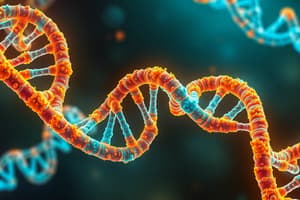Podcast
Questions and Answers
What do domain classes or data entities represent in the context of a system's problem domain?
What do domain classes or data entities represent in the context of a system's problem domain?
- Abstract ideas within the scope of the new system
- User interfaces and system components
- Data integrity and consistency
- Real-world entities or concepts in a system (correct)
What is the primary role of data entities in managing system information?
What is the primary role of data entities in managing system information?
- Clarity about system components
- Guiding the design of databases
- Providing an accurate representation of the information (correct)
- Ensuring data integrity and consistency
What is the significance of properly defining data entities?
What is the significance of properly defining data entities?
- Enhancing user interfaces and system components
- Optimizing database performance
- Providing clarity about system components
- Ensuring data integrity and consistency within the system (correct)
In the context of a system's problem domain, what do 'Things' refer to?
In the context of a system's problem domain, what do 'Things' refer to?
What is the role of data entities in guiding the design of databases?
What is the role of data entities in guiding the design of databases?
What area of the users' business need is within the scope of the new system?
What area of the users' business need is within the scope of the new system?
What do domain classes or data entities represent in a system?
What do domain classes or data entities represent in a system?
What do 'Things' represent in the context of a system's problem domain?
What do 'Things' represent in the context of a system's problem domain?
What is the primary role of domain classes or data entities in a system?
What is the primary role of domain classes or data entities in a system?
What is the significance of 'Things' in a system's problem domain?
What is the significance of 'Things' in a system's problem domain?
What do data entities ensure within a system?
What do data entities ensure within a system?
What do domain classes or data entities provide in terms of system components?
What do domain classes or data entities provide in terms of system components?
What are the two techniques for identifying domain classes/data entities?
What are the two techniques for identifying domain classes/data entities?
What is the brainstorming technique for identifying domain classes?
What is the brainstorming technique for identifying domain classes?
What is the noun technique for identifying domain classes?
What is the noun technique for identifying domain classes?
What are domain classes?
What are domain classes?
What do associations represent?
What do associations represent?
What do attributes describe in domain classes?
What do attributes describe in domain classes?
What uniquely identifies an instance of the class?
What uniquely identifies an instance of the class?
What are associations in terms of relationships?
What are associations in terms of relationships?
What are the types of associations mentioned in the text?
What are the types of associations mentioned in the text?
What is the focus of the chapter in the context of systems analysis?
What is the focus of the chapter in the context of systems analysis?
How are domain classes or data entities modeled?
How are domain classes or data entities modeled?
What is the purpose of the checklist brainstorming technique?
What is the purpose of the checklist brainstorming technique?
Flashcards are hidden until you start studying
Study Notes
Identifying Domain Classes and Associations in Systems Analysis
- Techniques for identifying domain classes include a checklist brainstorming technique and the noun technique
- The brainstorming technique involves identifying a user and use cases, then systematically asking questions to identify potential things involved in carrying out the use case
- The noun technique involves identifying problem domain classes by refining a list of nouns that come up in discussions or documents
- It is a popular technique and a good starting point when there are no users available to help brainstorm
- Domain classes have attributes and associations, and associations are naturally occurring relationships among classes
- Attributes describe one piece of information about each instance of the class
- An identifier or key uniquely identifies an instance of the class, and there are compound attributes
- Associations can be binary, unary (recursive), ternary, or N-ary, and they are "using" relationships between objects with their own lifetimes
- Associations have minimum and maximum multiplicity, and they apply in two directions with constraints
- The chapter focuses on modeling functional requirements as part of systems analysis
- The "things" in the problem domain are identified and modeled as domain classes or data entities
- The two techniques for identifying domain classes/data entities are the brainstorming technique and the noun technique
Studying That Suits You
Use AI to generate personalized quizzes and flashcards to suit your learning preferences.




